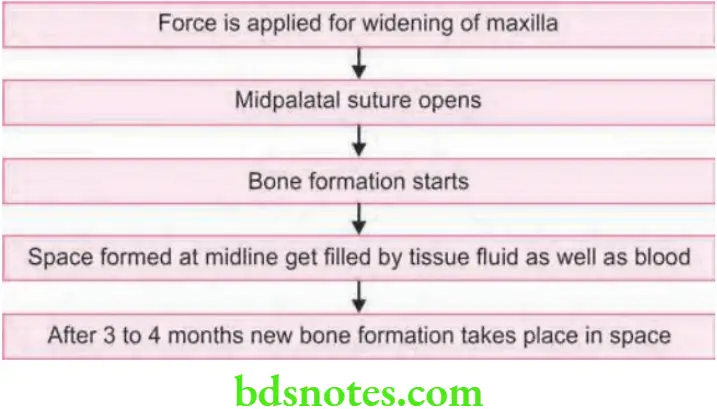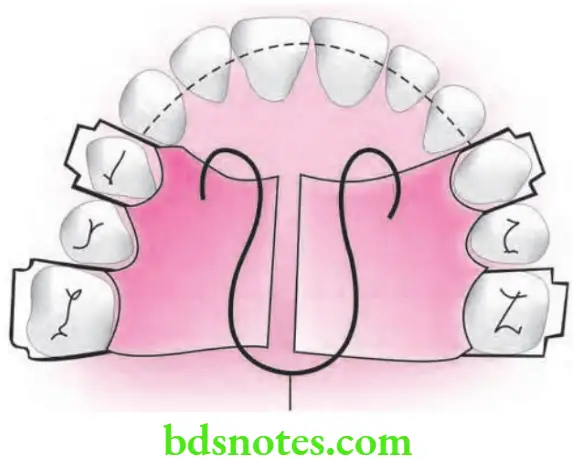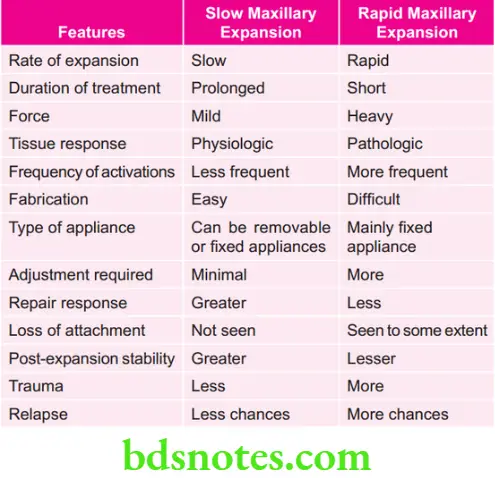Arch Expansion As Method Of Gaining Space
Question 1. What are the various method of gaining space in orthodontics? Describe in detail rapid maxillary expansion.
Or
Enumerate the various methods of gaining space in orthodontic. Describe rapid maxillary expansion in detail.
Or
Enumerate methods of gaining space during orthodontics treatment. Describe rapid maxillary expansion in detail.
Or
Enumerate space gaining methods in orthodontics. Describe rapid maxillary expansion.
Or
Enumerate various methods of gaining space. Describe in detail the indication, contraindication, effects on skeletal and dental tissues and activation schedule of rapid maxillary expansion.
Or
Describe rapid maxillary expansion in detail.
Or
Enumerate various indications for rapid maxillary expansion. Describe in detail the effects and appliances used for rapid maxillary expansion.
Answer. Space is required for correction of crowding, retraction of proclined teeth, leveling the steep curve of Spee, derotation of anterior teeth and for correction of unstable molar relation.
Read And Learn More: Orthodontics Question And Answers
Methods of Gaining Space
Methods of gaining space are divided into two types, i.e.
- Procedures with reduction of tooth material
- Proximal stripping or slicing.
- Extraction.
- Procedures without reduction of tooth material
- Expansion.
- Labial proclination.
- Distalisation of molars.
- Derotation of posterior teeth.
- Uprighting.
Rapid Maxillary Expansion (RME)
An apparently complex yet relatively simple procedure in orthodontics is palatal expansion.
- Rapid maxillary expansion is also known as the “rapid palatal expansion” or “split palate”.
- It is a skeletal type of expansion that involves the separation of the mid-palatal surface and the movement of maxillary shelves away from each other.
- Emerson C Angel is considered the father of rapid maxillary expansion.
- Angel, fist time in 1860, used a jack screw type of device between the maxillary premolar.
- The intermaxillary and the interpalatine sutures are collectively called mid-palatine suture, rapid maxillary expansion should be initiated prior to the ossification of mid-palatine suture.
- Broad range of ossification time is 15 to 27 years.
Indications for Rapid Maxillary Expansion
Orthodontic Indications
- In unilateral or bilateral posterior skeletal crossbite.
- In narrow maxilla in certain class 2 cases.
- In class 3 malocclusion.
- In collapsed maxillary arch due to clef palate.
- Along with reverse pull headgear for loosening the sutures.
- In anterior crossbite for gaining space.
- In high angle cases, here bonded RME is used.
Medical Indications
- In poor nasal airway
- In septal deformity
- In recurrent ear or nasal infections
- In cases of asthma
- In patients with allergic rhinitis
- In cases of septal deformity.
Types of Appliance Used
Broadly classified as:
- Removable appliances.
- Fixed appliances.
- Bonded or banded.
- Tooth borne or tooth and tissue borne.
Removable Appliances
Removable type of rapid maxillary expansion device consists of a split acrylic plate with a midline screw. The appliance is retained using clasps on the posterior teeth.
- Treatment during the deciduous or early mixed dentition is more favorable in producing skeletal effects.
- Disadvantage: Need for patient cooperation.
- Difficulty in relating the palate inside the mouth.
Fixed Appliances
Appliances that are fixed onto the teeth are more reliable and found to produce consistent skeletal effects.
Banded rapid maxillary expansion appliances
Classification of banded fixed appliances
Tooth and Tissue Borne Appliances
- Derichsweiler type.
- Hass type.
Tooth borne appliances
- Isaacson type.
- Biedermann type.
Derichsweiler type
- First premolar and fist molars are banded.
- Wire tags are soldered onto the palatal aspect of band.
- Wire tags get inserted into a split palatal acrylic incorporating a screw at its center.
- Acrylic adapts the palate and is in two halves to permit activation of screw.
Hass type
- First premolar and fist molar are banded.
- A thick stainless steel wire of 1.15 mm diameter is soldered on the buccal and lingual side of bands.
- The lingual extensions are longer and get embedded in the palatal acrylic.
- The split palatal acrylic has a midline screw.
Isaacson type
- This is a tooth borne appliance without any acrylic palatal covering.
- This appliance uses spring loaded screw called MINNE expander.
- The fist premolar and fist molar are banded.
- Metal flanges are soldered onto the buccal and lingual sides.
- The expander consists of a coil spring having a nut.
- This coil spring is made to extend between the lingual metal flnges that have been soldered.
- The expander is achieved by closing the nut so that the spring gets compressed.
Biedermann type
- This type of appliance uses a specific type of screw called HYRAX (Hygienic rapid expander).
- It has heavy wires which are adapted, welded and soldered to palatal aspect of bands in molar and premolors.
Bonded rapid maxillary expansion appliance
In bonded rapid maxillary expansion bands are replaced by metallic cap splints or acrylic covers.
Metal cap splints
- Casting of cap splint to all the teeth is done which are prepared in which screw has to be soldered.
- The complete assembly is cemented or bonded.
Acrylic splint
- A thick stainless steel wire is adapted from premolar to molar buccally and palatally.
- Soldering of screw is done with wire.
- Covering of acrylic is done at occlusal, buccal and palatal occlusal third from premolar to molar.
- Complete assembly is bonded or cemented.
Principle of Rapid Maxillary Expansion

Management by Appliance
According to Timms, management by appliance should be done at three ages, i.e.
- Before 15 years
- Activation is done twice daily.
- 180° activation is done everyday, i.e. 90° rotation each time.
- 0.5 mm/day.
- Review is done after one week.
- 15-20 years
- Activation is done four times a day.
- 180° activation is done everyday, i.e. 45° rotation each time.
- 0.5 mm/day.
- Review is done after one week.
- Above 20 years
- Activation is done twice daily.
- First activation is done at 90° and second activation is of 45°.
- Review is done after 3-4 days.
Retention of Appliance
- Same rapid maxillary expansion appliance should act as retainer for first three months.
- Removable retainer should be given from 4th month.
- Removable retainer should be worn full time for 9 month and after 9 months half time wear is advised.
Effects of Rapid Maxillary Expansion
Effects of rapid maxillary expansion are divided into effects on following tissues:
Changes in Bone
- Lateral movement of maxilla.
- Rotation of maxilla with fulcrum at frontonasal suture.
- Nasal airways get increased and airway resistance decreases.
- Rotation of mandible occurs in downward and backward direction.
- Mandibular angle increases.
Changes in Suture
- Due to opening of sutures a space is formed which is filed by blood and tissue fluid.
- At edge of palatal process bone deposition occur.
- Bone is formed in the space.
Changes in Dentition
- Labial movement of teeth because of translation.
- Buccal inclination of posterior teeth increases.
- Posterior teeth get slightly extruded.
- Midline diastema occur.
Contraindication of Rapid Maxillary Expansion
- Single tooth crossbite.
- Uncooperative patient.
- After ossification of mid-palatal suture.
- Skeletal asymmetry of maxilla and mandible and adult cases with severe anteroposterior skeletal deformities.
- Vertical grooves with steep mandibular plane angle.
- As posterior teeth are used as anchors to move bones apart, the procedure is not indicated in periodontally weak dentition.
Question 2. Write short note on expansion screw.
Answer. An expansion screw is used for expansion of arch, e.g. in rapid maxillary expansion or in slow expansion or in patient of unilateral or bilateral crossbite.
- A typical expansion screw consists of a long body divided into two halves.
- Each half has a threaded inner side that receives one end of a double ended screw.
- Screw has a centered boxing with four holes.
- These holes receive a key which is used to turn the screw.
- Turning of the screw by 90 degree, (i.e. one turn bring about a linear movement of 0.18 mm).
- The pattern of threading on either side is of opposite direction.
- Thus, turning the screw withdraws it from both sides simultaneously.
- Various expansion screws which are used in removable and fixed appliances are jackscrews, coffin springs, quad helix, Isaacson, hyrax, Derichsweiler
Activation Schedule
For achieving the desirable results, different activation schedules are given by various authors, out of which the two are most popular i.e.
According to Timms
- Patients aged till 15 years: 90° rotation is given in morning and evening
- Patients aged over 15 years: 45° rotation is given four times a day.
According to Zimring and Isaacson
- In growing individuals: Two turns are given each day for 4 to 5 days and later one turn per day for next 5 to 7 days and one turn every alternate day till the desired expansion is achieved.
- In non – growing individuals: Two turns each day for fist two days and later one turn per day for next 5 to 7 days and one turn every alternate day till desired expansion is achieved.
Question 3. Write short note on slow maxillary expansion.
Or
Write short note on slow expansion.
Answer.
Slow Maxillary Expansion
- Maxillary arch expansion is done at slow rate, i.e. 0.5 to 1 mm/week.
- It is more stable, lesser chances of relapse.
- Forces generated by such procedure is much lower, i.e. 2-4 pounds.
- Slow expansion procedure takes more time, i.e. 2-5 months.
- Slow expansion is also termed dentoalveolar expansion.
- Type of tissue reaction is more physiologic.
Classification of Slow Expansion Appliances
They are classified as:
- Removable slow expansion appliances
- Expansion plate with jackscrew
- Coffin springs
- Removable quad helix.
- Fixed slow expansion appliances
- W arch appliance
- Quad helix
- Expansion screw
- Fixed appliance.
Slow Expansion Indications
- Relieve crowding in less space discrepancy.
- In posterior dental crossbite in a single or two teeth
- In clef palate patients with destroyed maxilla.
- In constricted maxillary arch.
Slow Expansion Advantages
- Has good physiological response.
- Produce less damage to dentition.
- Leads to skeletal effect in child patients.
Slow Expansion Disadvantages
It causes tipping rather than bodily expansion of teeth.
Question 4. Write short note on role of expansion in orthodontics.
Answer. Expansion in orthodontics is of two types, i.e. rapid maxillary expansion and slow maxillary expansion.
- Rapid maxillary expansion leads to skeletal arch expansion.
- Rapid maxillary expansion is indicated in the following cases in orthodontics:
- In class 3 malocclusion
- In posterior skeletal crossbite either unilateral or bilateral.
- In some class 2 cases in which maxilla is narrow.
- In clef palate cases with destroyed maxillary arch.
- For gaining space in anterior crossbite.
- In high angle cases.
- Slow maxillary expansion leads to dentoalveolar expansion.
- Slow maxillary expansion is in the following cases in orthodontics:
- Relieve crowding in less space discrepancy.
- In posterior dental crossbite in a single or two teeth.
- In clef palate patients with destroyed maxilla.
- In constricted maxillary arch.
Question 5. Write short notes on appliances used for dental and skeletal arch expansion.
Answer.
Appliances Used for Dental Arch Expansion
- Slow arch expansion appliances causes dental arch expansion.
- Some of the appliances which causes dental arch expansion are:
- Jack screw: Jack screw for slow expansion has more spread out activation schedule and have a smaller pitch than those of rapid maxillary expansion.
- Coffin spring: This appliance was by Walter Coffi
- It is a removable appliance capable of slow dentoalveolar expansion.
- Appliance consists of an omega shaped wire placed in midpalatal region.
- Free end of omega embedded in acrylic covering the slopes of the palate.
- Spring is activated by pulling the two side by using three-prong pliers.
Quad Helix—Used to Expand Narrow Maxilla
- It have evolved from the original coff loop.
- Quad helix incorporates four helices that increases the wire length, therefore the flxibility and range of action is more.
- Wire of helix is soldered to band on the fist molar.
- Parts:
- Two anterior helices.
- Two posterior helices.
- Anterior bridge-wire between anterior helices.
- Palatal bridge-wire between anterior and posterior helices.
- Free wire ends—outer arms.
- Quad helix bring about slow dentoalveolar expansion.

Question 6. Briefly differentiate between slow and rapid expansion.
Or
Distinguish between rapid maxillary expansion and slow maxillary expansion.
Answer.

Question 7. Write short note on hyrax screw.
Answer. Full form of HYRAX is hygienic rapid expander.
- The tooth borne appliance use a special type of screw which is known as HYRAX.
- HYRAX screw is an expansion appliance.
- HYRAX screw consists of heavy gauge wire extension which is adapted in such a way that it follows the contour of palate.
- HYRAX screw is soldered to bands on molars and premolars.
- It is of two types, i.e. banded Hyrax appliance and bonded Hyrax appliance.
Banded Hyrax Appliance
- Hyrax screw is soldered to the bands over fist premolar and molar.
- It provides the advantage of hygiene due to less coverage of gingiva.
- Disadvantage of appliance is that chair side time enhances and wire banding as well as soldering should be done precisely.
Bonded Hyrax Appliance
- Arms of the Hyrax screw are attched to the acrylic cap splint on both sides.
- Acrylic cap splint covers the posterior teeth on both sides.
- Appliance is very popular because of ease of its cementation at mixed dentition period.
- Chair side time is very less and is completed in two appointments.
- Maintains good oral hygiene since coverage of appliance is 1 mm short of gingival margin.
- The appliance maintains overbite control.

Leave a Reply